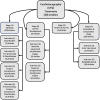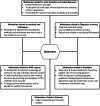A systematic review of automated pre-processing, feature extraction and classification of cardiotocography
- PMID: 33987454
- PMCID: PMC8093951
- DOI: 10.7717/peerj-cs.452
A systematic review of automated pre-processing, feature extraction and classification of cardiotocography
Abstract
Context: The interpretations of cardiotocography (CTG) tracings are indeed vital to monitor fetal well-being both during pregnancy and childbirth. Currently, many studies are focusing on feature extraction and CTG classification using computer vision approach in determining the most accurate diagnosis as well as monitoring the fetal well-being during pregnancy. Additionally, a fetal monitoring system would be able to perform detection and precise quantification of fetal heart rate patterns.
Objective: This study aimed to perform a systematic review to describe the achievements made by the researchers, summarizing findings that have been found by previous researchers in feature extraction and CTG classification, to determine criteria and evaluation methods to the taxonomies of the proposed literature in the CTG field and to distinguish aspects from relevant research in the field of CTG.
Methods: Article search was done systematically using three databases: IEEE Xplore digital library, Science Direct, and Web of Science over a period of 5 years. The literature in the medical sciences and engineering was included in the search selection to provide a broader understanding for researchers.
Results: After screening 372 articles, and based on our protocol of exclusion and inclusion criteria, for the final set of articles, 50 articles were obtained. The research literature taxonomy was divided into four stages. The first stage discussed the proposed method which presented steps and algorithms in the pre-processing stage, feature extraction and classification as well as their use in CTG (20/50 papers). The second stage included the development of a system specifically on automatic feature extraction and CTG classification (7/50 papers). The third stage consisted of reviews and survey articles on automatic feature extraction and CTG classification (3/50 papers). The last stage discussed evaluation and comparative studies to determine the best method for extracting and classifying features with comparisons based on a set of criteria (20/50 articles).
Discussion: This study focused more on literature compared to techniques or methods. Also, this study conducts research and identification of various types of datasets used in surveys from publicly available, private, and commercial datasets. To analyze the results, researchers evaluated independent datasets using different techniques.
Conclusions: This systematic review contributes to understand and have insight into the relevant research in the field of CTG by surveying and classifying pertinent research efforts. This review will help to address the current research opportunities, problems and challenges, motivations, recommendations related to feature extraction and CTG classification, as well as the measurement of various performance and various data sets used by other researchers.
Keywords: Acceleration; Baseline; Cardiotocography; Classification; Diagnoses; Feature extraction; Fetal Heart Rate; Uterine contraction; Variability.
©2021 Al-yousif et al.
Conflict of interest statement
The authors declare there are no competing interests.
Figures







References
-
- Arif M. Classification of cardiotocograms using random forest classifier and selection of important features from cardiotocogram signal. Biomaterials and Biomechanics in Bioengineering. 2015;2(3):173–183. doi: 10.12989/bme.2015.2.3.173. - DOI
-
- Chamidah N, Wasito I. Fetal state classification from cardiotocography based on feature extraction using hybrid K-Means and support vector machine,. International conference on advanced computer science and information systems (ICACSIS); Piscataway. 2015. pp. 37–41.
-
- Chinnasamy S, Muthusamy C, Gopal G. An outlier based bi-level neural network classification system for improved classification of cardiotocogram data. Life Science Journal. 2013;10(1):244–251.
LinkOut - more resources
Full Text Sources
